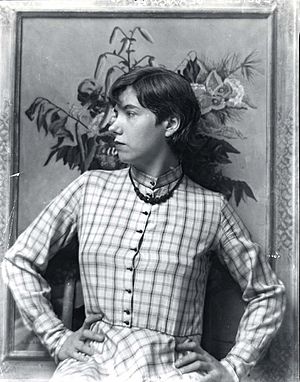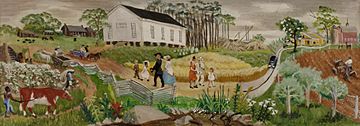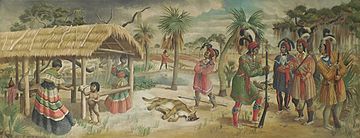Lucile Blanch facts for kids
Quick facts for kids
Lucile Blanch
|
|
|---|---|

Blanch in 1930
|
|
| Born |
Lucile E. Lundquist
December 31, 1895 Hawley, Minnesota, U.S.
|
| Died | October 31, 1981 (aged 85) Kingston, New York, U.S.
|
| Education | Minneapolis School of Art |
| Known for | Painting |
Lucile Esma Lundquist Blanch (December 31, 1895 – October 31, 1981) was an American artist and teacher. She was known for painting large murals for government buildings during the Great Depression. She also received a special award called the Guggenheim Fellowship.
Contents
Early Life and Art School
Lucile Blanch was born in 1895 in Hawley, Minnesota. She grew up in the countryside of northern Minnesota. As a child, she loved gardening. Her mother wanted her to play piano, but Lucile preferred art.
After school, she briefly went to a college for teachers. But she really wanted to study art. She wrote a long letter to her parents explaining her dream.
Lucile went to the Minneapolis School of Art. There, she studied with artists like Harry Gottlieb and Adolf Dehn. In 1918, she moved to New York City. She studied at the Art Students League of New York with Boardman Robinson. She was one of only ten students that year to get a full scholarship.
She also studied with other famous artists. Lucile became friends with Eugenie Gershoy, who made a sculpture of her working.
Lucile married another artist, Arnold Blanch, in New York. They traveled to France to continue their art studies. Later, they moved to Woodstock, New York. They helped build up the art colony there.
The couple became friends with famous artists Diego Rivera and Frida Kahlo. They even shared a studio building in San Francisco for a time. Lucile and Arnold Blanch later divorced in 1935.
Art Career and Exhibitions
After moving to Woodstock, Lucile Blanch started showing her artwork. She exhibited in local shows and with groups like the New York Society of Women Artists. She also showed her art at the Whitney Studio Club.
Lucile and Arnold became important artists in the Woodstock art community. To support themselves, they wove and sold tapestries. They also ran a small cafeteria.
In 1933, Lucile Blanch received the Guggenheim Fellowship. This award helped her art become known. Her work was shown in many important places. From 1932 to 1943, major museums bought her paintings. These included the Metropolitan Museum of Art, the Museum of Modern Art, and the Whitney Museum.
After her divorce, Blanch taught art at the Ringling School of Art in Florida. This was from 1935 to 1936.
In 1937, she had her own art show at the Milch Galleries. That same year, her paintings were part of an exhibition at the Whitney Museum. In 1939, she was in a watercolor show there. She also took part in an exhibition by the American Society of Painters, Sculptors, and Gravers.
From 1938 to 1941, Blanch was an artist-in-residence at Converse College in South Carolina. She continued to teach there until 1965.
In 1978, when she was 83, a special show of her art was held. It looked back at her long career.
Government Murals

Lucile Blanch was asked to paint murals for post offices. This was part of a New Deal program during the Great Depression. The program was run by the Section of Painting and Sculpture of the U.S. Treasury Department.
Artists competed to create these murals. Almost 850 artists painted 1371 murals. Most of these were placed in post offices. About 162 of these artists were women. The government used 1% of the cost of new post offices to pay for these artworks.
In 1938, Blanch painted a mural called Osceola Holding Informal Court with His Chiefs. It was for the post office in Fort Pierce, Florida. Today, you can see this mural at Fort Pierce City Hall.
In 1940, she painted Appalachia for the post office in Appalachia, Virginia. Her mural Rural Mississippi from Early Days to Present was finished in 1941. It is in the Tylertown, Mississippi post office.
She also painted murals for post offices in Flemingsburg, Kentucky, and Sparta, Georgia. The Flemingsburg mural, Crossing to the Battle of Blue Licks, was done in 1943. The Sparta project had three panels. They showed an old plantation house, a granite quarry, and local scenery.
Art Style
When Lucile Blanch started her career, she painted realistic subjects. But over time, her art became more abstract. By 1928, her style was known for its bright colors and humor. She often painted circus performers and animals shown in spotlights.
Awards and Honors
In 1931, Lucile Blanch won the Medal of First Award for Graphic Arts. This was at the San Francisco Art Association's yearly exhibit.
In 1933, she received a fellowship from the John Simon Guggenheim Memorial Foundation. This award allowed her to work on her painting abroad for one year. The fellowships that year were worth about $2,500 each.
In 1934, she won a prize for her artwork at the Wanamaker Regional Exhibition in New York.
Death
Lucile Blanch passed away in 1981. She is buried in the Woodstock Artists' Cemetery in Woodstock, New York.
Images for kids



